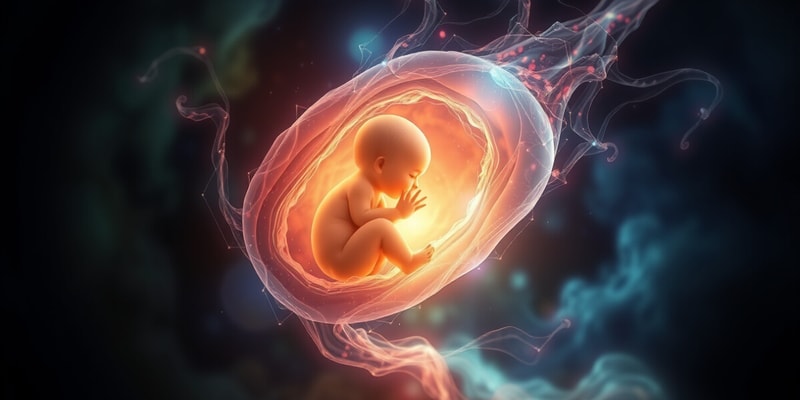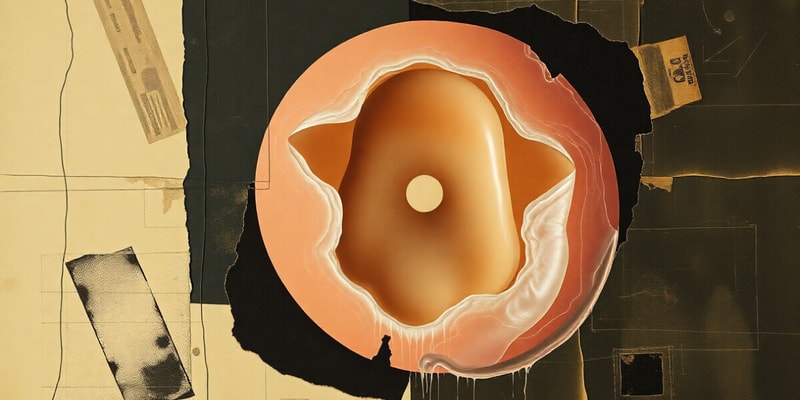Podcast
Questions and Answers
What is the stage of development from the 2-cell stage to before 8 weeks called?
What is the stage of development from the 2-cell stage to before 8 weeks called?
At the end of 9 weeks, a fetus is approximately 9 cm long and weighs about 26 g. Which of the following fruits is this weight most similar to?
At the end of 9 weeks, a fetus is approximately 9 cm long and weighs about 26 g. Which of the following fruits is this weight most similar to?
Which of the following does NOT occur during the 6-9 month period of fetal development?
Which of the following does NOT occur during the 6-9 month period of fetal development?
By week 24 of development, which organ is fully developed but not yet ready for gas exchange?
By week 24 of development, which organ is fully developed but not yet ready for gas exchange?
Signup and view all the answers
Which membrane surrounds the embryo and develops into a fluid-filled sac called the amniotic sac for protection and nourishment?
Which membrane surrounds the embryo and develops into a fluid-filled sac called the amniotic sac for protection and nourishment?
Signup and view all the answers
What is the purpose of the amniotic sac during pregnancy?
What is the purpose of the amniotic sac during pregnancy?
Signup and view all the answers
What is the purpose of a baby crying or coughing immediately after delivery?
What is the purpose of a baby crying or coughing immediately after delivery?
Signup and view all the answers
Identical twins occur when:
Identical twins occur when:
Signup and view all the answers
In a multiple birth scenario, what term is used for three babies born in a single pregnancy?
In a multiple birth scenario, what term is used for three babies born in a single pregnancy?
Signup and view all the answers
What is the main reason for the heart rate of the baby to slow down and stabilize after birth?
What is the main reason for the heart rate of the baby to slow down and stabilize after birth?
Signup and view all the answers
Which stage of development results in identical twins?
Which stage of development results in identical twins?
Signup and view all the answers
What is the function of the amniotic sac during the development of a baby?
What is the function of the amniotic sac during the development of a baby?
Signup and view all the answers
How are nutrients and oxygen transferred from the mother to the embryo?
How are nutrients and oxygen transferred from the mother to the embryo?
Signup and view all the answers
What is the main function of the placenta during pregnancy?
What is the main function of the placenta during pregnancy?
Signup and view all the answers
Why can't some diseases spread from the mother to the embryo?
Why can't some diseases spread from the mother to the embryo?
Signup and view all the answers
What type of cells are found in cord blood that can be grown into specific kinds of cells in the body?
What type of cells are found in cord blood that can be grown into specific kinds of cells in the body?
Signup and view all the answers
During labor, what physiological change allows for the baby to pass through the cervix?
During labor, what physiological change allows for the baby to pass through the cervix?
Signup and view all the answers
Study Notes
Protection and Nourishment
- Amniotic sac cushions and protects the developing baby from external bumps.
- Placenta: an organ that links the embryo to the mother, allowing for the exchange of materials between the two.
- Blood vessels of the embryo run next to the maternal blood vessels, but do not mix, allowing for the exchange of nutrients, oxygen, and waste.
Placenta
- Allows for the exchange of materials between the mother's blood and the embryo's blood.
- Prevents some diseases from spreading from the mother to the embryo, but not chemicals like alcohol and drugs.
Umbilical Cord
- A ropelike structure between the fetus and the placenta that contains blood vessels of the embryo.
- Does not contain maternal blood vessels.
- Cord blood contains stem cells that can be grown into specific kinds of cells in the body.
Birth
- Takes place in 3 stages: labor, birth, and delivery.
- Labor: strong muscular contractions in the uterus that widen the cervix to allow the baby to pass through.
Developmental Stages
- Blastocyst: a hollow ball of cells formed from the zygote cell through mitosis.
- Embryo stage: from 2 cell stage to 8 weeks of development.
- Fetus stage: from 9 weeks until birth.
Fetal Development
- From 9 weeks to birth:
- Internal organs develop.
- Brain develops rapidly.
- Clear dark eye patches, fingers, and toes form.
- Between 4-6 months:
- Bones become distinct.
- Lanugo (fine soft hair) develops all around the fetus.
- Heartbeat can be heard.
- Limbs are more completely developed.
- Fetus moves, indicating muscle development.
- At the end of 9 weeks, the fetus is about 9 cm long and weighs about 26 g.
- At the end of 6 months, the fetus is about 30 cm long and weighs about 700 g.
- From 6 to 9 months:
- Brain continues to develop, forming grooves and ridges.
- Lungs become ready to perform gas exchange.
- Body develops reserves of body fat.
- Eyelids open.
- By week 36, the body loses lanugo and has hair on its head.
- At the end of 9 months, the fetus is about 60 cm in length and weighs about 3 kg.
Multiple Births
- Multiple birth: more than one baby in a single pregnancy.
- Twins: 2 babies, can be identical or non-identical.
- Triplets: 3 babies, less frequent, usually artificial.
- Quadruplets: 4 babies, less frequent, usually artificial.
Identical Twins
- Occurs when a single sperm fertilizes a single egg, which splits and forms identical embryos early in development.
- Contains identical genetic material and will have identical inherited traits.
Studying That Suits You
Use AI to generate personalized quizzes and flashcards to suit your learning preferences.
Related Documents
Description
Learn about how the amniotic sac protects the developing baby and the role of the placenta in providing nutrition and protection. Discover how the barrier between the mother's blood and the embryo's blood allows for the exchange of materials necessary for development.




